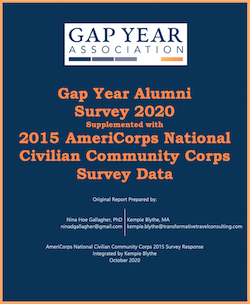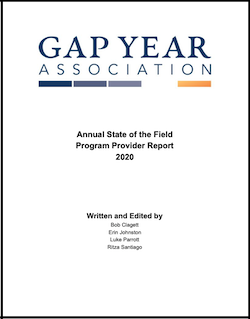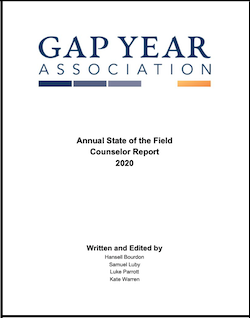Current Gap Year Research
These are our current research efforts, pioneered by the Gap Year Association's Research Committee. Each year we hold awards at our annual conference to highlight the pioneering research being done in the gap year space. The award is named after Karl Haigler, our emeritus Board Member and founder of the GYA Research Committee. We have several research efforts either ongoing or launching very soon:
2020 Gap Year Alumni Survey
Following the highly successful 2015 National Alumni Survey, the Gap Year Association commissioned the efforts of Kempie Blythe, MA, and reprising her role from the 2015 survey, Nina Hoe Gallagher, PhD, as well as the GYA Research Committee, to complete the 2020 Gap Year Alumni Survey. The previous survey has been cited by scholars, media, and providers demonstrating strong returns for gap year participants and this data more than confirms the great results we see through almost every gap year graduate.
In total, 1,795 respondents began the Gap Year Alumni 2020 Survey, and of those, 1, 596 participated in a “gap year” that aligned with the definition in the survey and 1,139 were eligible as permanent residents or citizens of the U.S. or Canada. A total of 1,190 gap year alumni completed this survey. The Alumni Outcomes Summary Report 2015 collected stratified data from a total of 498 NCCC alumni from 2004, 2009, and 2012 (respectively 10, 5, and 2 years after the end of service).
Annual State of the Field Survey - 2019/2020
Each year the GYA Research Committee authors a survey tool to track year-over-year trends for gap year participation and outcomes as a short-term snapshot. In 2019/20 we had reporting from almost 50 organizations and expect that to grow each year. The tool answers questions about enrollment, demographics, marketing, and early outcomes. The Research Committee takes the completed data and shares two reports, one comprehensive (reserved only for survey participants), and one general version that is available to the public. Click here for the 2019 survey.
Surveys will be launched in the spring of each year, and finalized in the summer of that same year. We have two separate survey results as the committee continues to reach new heights of quality: Gap Year Programs, and Gap Year Counselors.
Research Statement, from Nina Hoe Gallagher, Ph.D
The idea of a “gap year” has generated substantial interest among popular media sources, academic scholars, and prestigious institutions in the United States in recent years. The Gap Year Association asserts that gap years can take place either domestically or internationally, but must involve, “increasing self-awareness, learning about different cultural perspectives, and experimenting with future possible careers” (“What is a Gap Year?,” 2013). Gap years are more common for students in the United Kingdom, other parts of Europe, and Australia than they are in the U.S.; however, they are increasing in popularity in the U.S. as evidenced by a booming industry of gap year programs, the prolific publication of resource guides, and the inception of the Gap Year Association, an accreditation and standards-setting organization for gap years that is recognized by the U.S. Department of Justice and the Federal Trade Commission.
The following chart details the most significant outcomes reported while on their gap year as reported from the National Gap Year Alumni Survey in 2015. Data are color-coded based on Personal, Global Engagement, and Career & College categories.
Although there have been few empirical studies undertaken to examine gap year experiences for American students, in general, it is believed that taking a gap year is a valuable endeavor. U.K. Foreign Secretary, Jack Straw, has publicly promoted gap year practices, arguing that, “Taking a gap year is a great opportunity for young people to broaden their horizons, making them more mature and responsible citizens. Our society can only benefit from travel which promotes character, confidence, [and] decision-making skills” (as cited in Simpson, 2005, p. 453). To date, much anecdotal evidence as well as some peer-reviewed studies have identified positive effects associated with participation, relating to language development (“Bridge Year Program,” n.d.; Clagett, 2012; King, 2011; Lyons et al., 2012; Simpson, 2005; Spenader, 2011), personal growth (Birch & Miller, 2007; “Bridge Year Program,” n.d.; King, 2011; Knight, 2014; Martin, 2010; O'Shea, 2011b; Stehlik, 2010), and college and career attainment for students in the U.K. and Australia (Birch & Miller, 2007; King, 2011; Knight, 2014; Martin, 2010; O'Shea, 2011b; Stehlik, 2010). Across the U.S., no fewer than 160 colleges and universities have begun to embrace the idea of a Gap Year, with differing degrees of intensity (“University in Support of Gap Year,” n.d.) Most commonly, institutions provide deferral information, and opportunities and requirements on their admissions websites. For example, Middlebury College’s admissions page includes, “A Special Message from the Dean of Admissions to All Prospective Applicants to Middlebury College” about taking a gap year. Harvard University recommends taking a gap year in its acceptance letter. The University of North Carolina – Chapel Hill offers scholarships to students wanting to take a gap year through their Global Gap Year Fellowship at the Campus Y.
A recent methodology to track gap year students’ over/underperformance of GPA was designed by Bob Clagett, former Dean of Admissions at Middlebury College. This methodology tracked the academic rating of an incoming student including everything of an academic nature that is received in the application process. When Clagett controlled for the academic rating and looked at the actual academic performance of students who took a gap year compared to their predicted performance based on their academic rating, students who took a gap year almost always overperformed academically in college, usually to a statistically significant degree, and most importantly, the positive effect of taking a gap year was demonstrated to endure over all four years.

Princeton University has started its own Bridge Year Program which "offers a truly innovative approach to learning, one that is more experiential and more profoundly transformational than anything most students entering college will have encountered during high school. The knowledge, understanding, and skills gained through the Bridge Year serve not only to enhance a student’s undergraduate experience at Princeton, but also contribute to the overall strength of the University’s educational community." ("Bridge Year Program," n.d.)
Belief in the benefits of gap year or bridge year experiences to both students and institutions are driving increasing support from colleges and universities.
Despite the growing popularity, there is a dearth of scholarly research on nature and outcomes of gap year experiences in general (King, 2011; O'Shea, 2011b; Stehlik, 2010). Of the existing peer-reviewed research, which is limited to approximately ten studies, only one focuses on American students. Also, few of the studies have included sample sizes of greater than 30 (O'Shea, 2011b; Spenader, 2011).
This study aims to better understand the population of students who have previously participated in gap years, as well as the group of students participating in gap year programs accredited by the GYA. In addition, this study aims to identify the participant-reported effects of gap year participation. This study will use web-based survey methods to attain this information.
References
- Birch, E. R., & Miller, P. W. (2007). The characteristics of “gap-year” students and their tertiary academic outcomes. Economic Record, 83(262), 329–344.
- Bridge Year Program. (n.d.). Bridge Year Program. Princeton.Edu. Retrieved March 17, 2013, from http://www.princeton.edu/bridgeyear/
- Clagett, R. (2012, September 26). Regressions on GPA, Classes of 2011-14.
- King, A. (2011). Minding the gap? Young people's accounts of taking a Gap Year as a form of identity work in higher education. Journal of Youth Studies, 14(3), 341–357.
- Knight, E. (2014, March 20). Universities in support of gap years. gapyearassociation.org. Retrieved March 7, 2014, from http://gapyearassociation.org/fav-colleges.php
- Lyons, K., Hanley, J., Wearing, S., & Neil, J. (2012). Gap year volunteer tourism: Myths of Global Citizenship? Annals of Tourism Research, 39(1), 361–378.
- Martin, A. J. (2010). Should students have a gap year? Motivation and performance factors relevant to time out after completing school. Journal of Educational Psychology, 102(3), 561–576.
- O'Shea, J. (2011a). Delaying the Academy: A Gap Year Education. Dissertation.
- O'Shea, J. (2011b). Delaying the academy: A gap year education. Teaching in Higher Education, 16(5), 565–577.
- O'Shea, J. (2013). Gap year: How delaying college changes people in ways the world needs. The Johns Hopkins University Press.
- Simpson, K. (2005). Dropping out or signing up? The professionalisation of youth travel. Antipode, 37(3), 447–469.
- Spenader, A. (2011). Language learning and acculturation: Lessons from high school and gap-year exchange students. Foreign Language Annals, 44(2), 381–398.
- Stehlik, T. (2010). Mind the gap: school leaver aspirations and delayed pathways to further and higher education. Journal of Education and Work, 23(4), 363–376.



